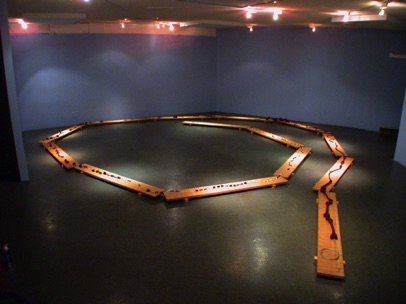Kalpa refers to the measure of an eon in Hindu and Buddhist literature. A Kalpa could be described as the amount of time it takes for a mile-high iron mountain to be worn down to the earth by a deva (heavenly being) descending from heaven every one hundred years and brushing this mountain with a silk scarf. Alternately, Zen priests have said, “with an inhalation I make the universe, with an exhalation, I destroy it.”
Kalpa is made of a series of iridescently grained redwood planks, sitting on short lengths of yellow canarywood. Upon these planks are a series of bones: human bones dipped in paint and flocked with a deep blood colored flocking and bleached coyote bones. The bones are tied together with a length of aircraft cable. All bones are arranged to ascend or descend in order of size, irregardless of species. Kalpa represents the passage of time, marked out, like beads of a rosary; each moment, unique yet linked by the structure of life. As one passes through time, these moments shrink in size and increase in number, like peering down a deep, long, circuitous hallway, or, ever expand and extend into gradually longer periods, until

one is left with eternity itself. Both rules of order meet the rich metaphor of time in these eastern traditions.





